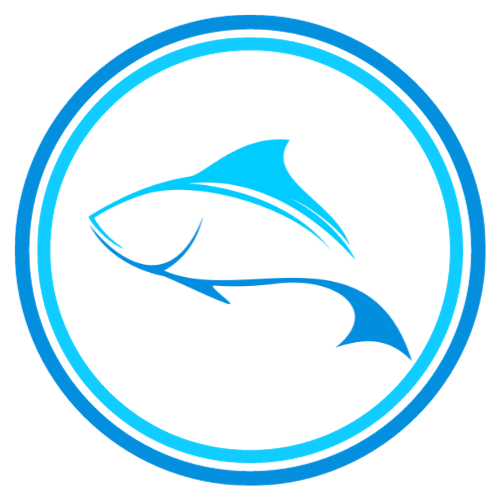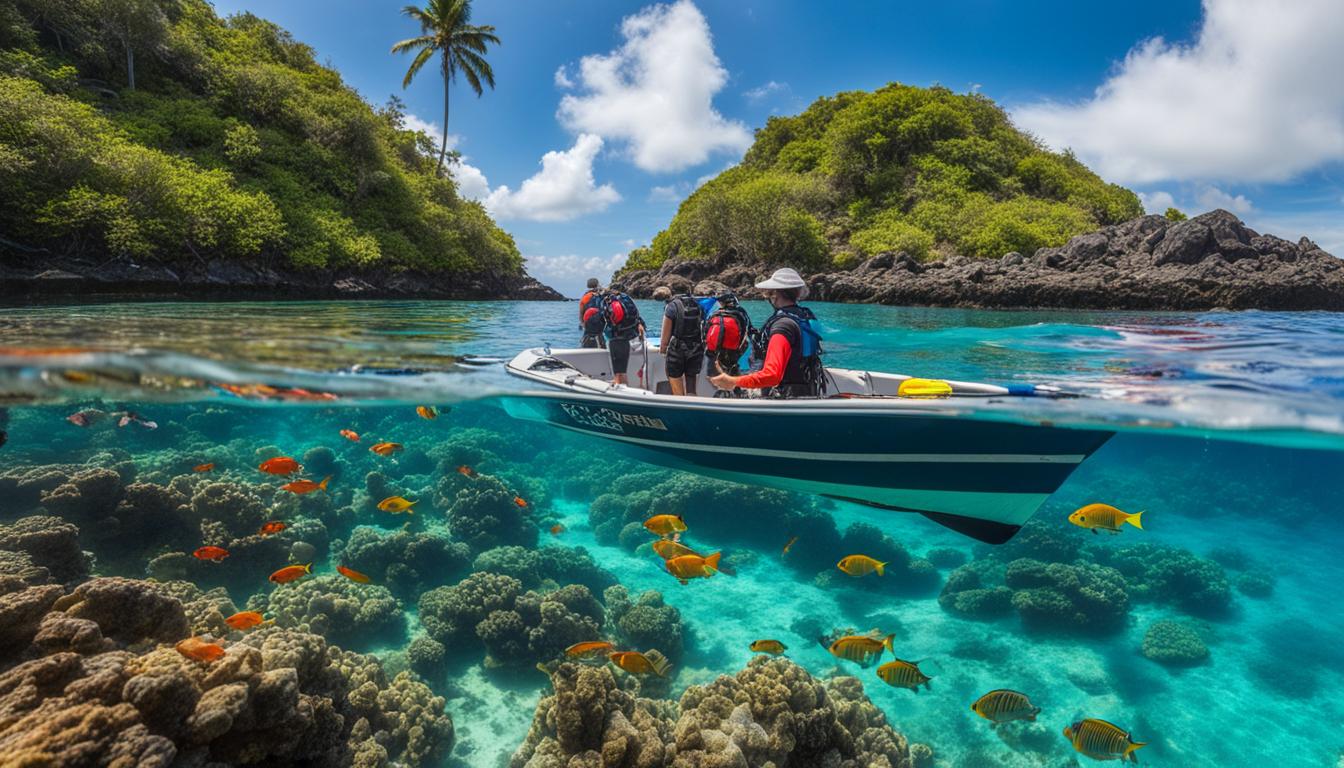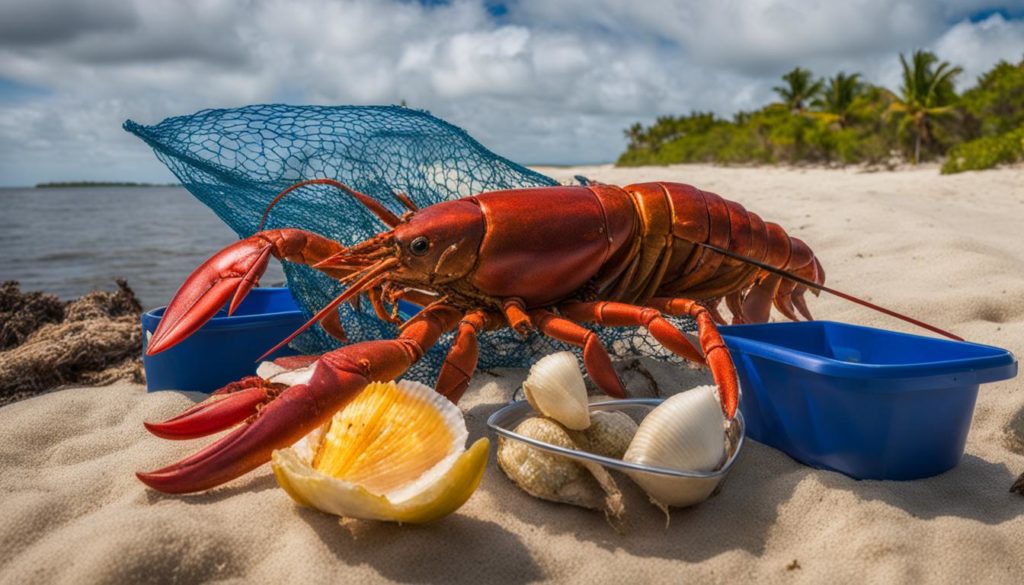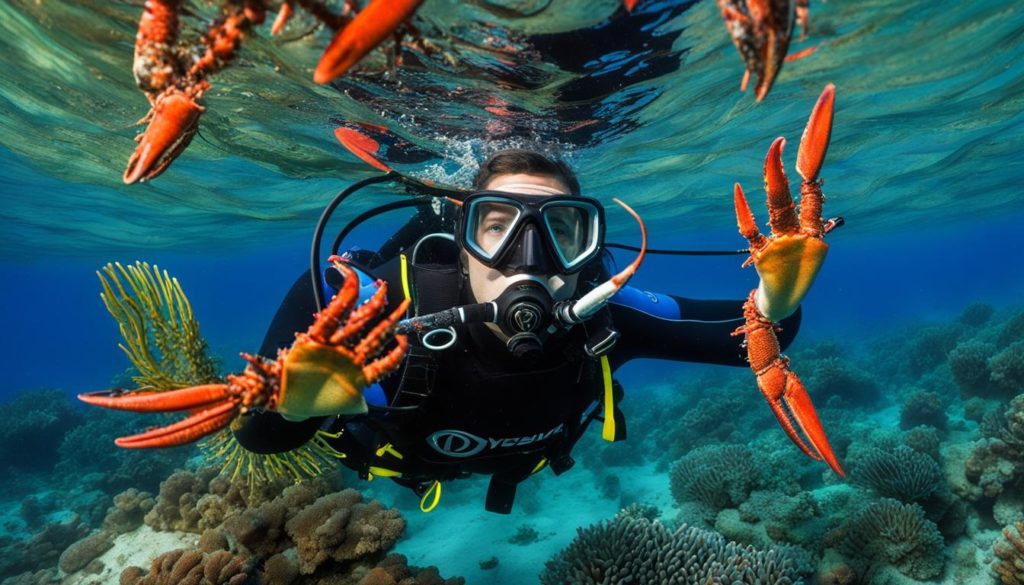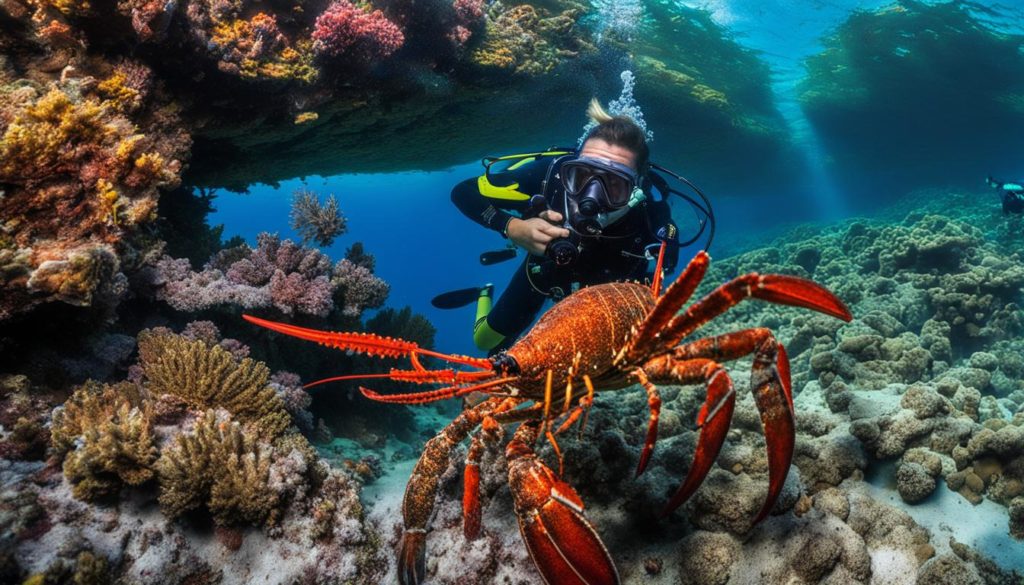Florida offers abundant opportunities for catching spiny lobsters by hand. Lobstering is a popular sport in the state, with many sportsmen venturing into the clear waters to secure their catch. While commercial lobstermen use traps, Florida sportsmen rely on hand-catching techniques. There are various methods for catching spiny lobsters, including using snares, nets, and the traditional tickle stick and gloved hand technique.
Key Takeaways:
- Florida offers ample opportunities for hand-catching spiny lobsters.
- Lobstering is a popular sport in Florida, with many sportsmen venturing into the clear waters to secure their catch.
- Hand-catching techniques, such as using snares, nets, and tickle sticks, are commonly used.
- Commercial lobstermen in Florida primarily use traps for catching spiny lobsters.
- There are specific regulations in place for catching spiny lobsters, such as size limits and restrictions on catching egg-bearing females.
Tips for Catching Spiny Lobsters by Hand in Florida
When it comes to hand-catching spiny lobsters in Florida, following these tips can greatly enhance your chances of success. First and foremost, preseason scouting is essential to locate the best areas for lobstering. Look for distinctive clues like bare spots on rock ledges or the presence of certain fish species that indicate the possibility of lobsters being nearby. However, finding productive areas during a dive is equally important, so keep your eyes peeled for any signs of lobster activity.
Once you’ve identified a potential lobster, it’s crucial to approach it with care. Use a tickle stick made of PVC tubing to gently nudge the lobster out of its hiding spot. Avoid grabbing or reaching for the lobster, as sudden movements can spook it. Instead, place your hand near its cranny and nudge it towards your waiting hand or net. Take your time and be patient, as rushing can lead to missed opportunities.
Pro Tip: Scout the layout of a lobster’s hideaway before attempting to catch it. Look closely for eggs on its underside, as catching egg-bearing females is not allowed.
When encountering a group of lobsters, work slowly and methodically to catch each one. Start with the smaller ones to avoid disturbing the larger ones. This approach ensures a more successful and enjoyable lobstering experience in the beautiful waters of Florida.
Table: Techniques for Catching Spiny Lobsters by Hand
| Technique | Description |
|---|---|
| Snares | Use specially designed snares to catch lobsters by looping the snare around their bodies |
| Nets | Employ nets to trap lobsters once they are out in the open |
| Tickle Stick and Gloved Hand | Use a tickle stick made of PVC tubing to gently nudge lobsters out of their hiding spots and catch them with a gloved hand |
By employing these tried and true techniques, you’ll increase your chances of having a successful lobstering adventure in the stunning waters of Florida. So gear up, dive in, and enjoy the thrill of catching spiny lobsters by hand!
Best Time and Places to Catch Spiny Lobsters in Florida
If you’re planning a lobstering adventure in Florida, it’s essential to know the best time and places to catch spiny lobsters. Timing is crucial, as the regular lobster season runs from August 6 to March 31, and the Mini Sport Season takes place on the last Wednesday and Thursday of July. These are the prime periods when lobstering enthusiasts flock to the waters to secure their catch.
As for the best places to catch spiny lobsters, the Southeast region of Florida, including the Florida Keys, is highly recommended. This area offers a diverse range of reefs, ledges, and wrecks that serve as ideal habitats for lobsters. The Middle Keys and the Lower Keys are also popular hotspots, with an abundance of reefs and permitted shipwrecks. Remember that lobsters tend to move around, so it’s crucial to scout for new spots each season to maximize your catch.
Best Time to Catch Spiny Lobsters
The regular lobster season in Florida is undoubtedly the ideal time to hunt for spiny lobsters. During this period, the lobsters are more active and accessible, making it easier to catch them by hand. However, the Mini Sport Season adds an extra thrill and opportunity for lobstering enthusiasts to dive into the waters before the regular season begins. It’s a unique chance to join the frenzy and compete with fellow lobstermaniacs for the biggest catch. Remember to always adhere to the regulations and guidelines set by the Florida Fish and Wildlife Conservation Commission to ensure the sustainability of the lobster population.
Best Places to Catch Spiny Lobsters
The Florida Keys, located in the Southeast region, are hailed as the lobstering paradise of Florida. You’ll find an extensive network of coral reefs, ledges, and shipwrecks that provide shelter for spiny lobsters. The Middle Keys and the Lower Keys are particularly renowned for their rich lobster populations. The diverse marine ecosystems in these areas attract lobsters and offer exciting opportunities for lobstering. Explore the crystal-clear waters and hidden crevices, and you’ll be rewarded with a memorable lobstering experience.
| Location | Description |
|---|---|
| Florida Keys | The Florida Keys are a chain of islands renowned for their coral reefs, providing an excellent habitat for spiny lobsters. |
| Middle Keys | The Middle Keys offer a diverse array of reefs and underwater structures where lobsters thrive. |
| Lower Keys | The Lower Keys are home to abundant reefs and permitted shipwrecks that attract spiny lobsters. |
Remember, part of the thrill of lobstering is exploring new spots and discovering your own secret lobstering locations. So grab your gear and dive into the waters of Florida for an unforgettable lobstering adventure!
Gear Up for Lobstering in Florida
When gearing up for lobstering in Florida, there are a few essential items you’ll need. The most important piece of equipment is a good pair of gloves, which will allow you to comfortably grip the lobsters without hurting yourself. Look for gloves that don’t snag on rocks, offer palm protection, and still provide dexterity.
Additionally, other useful equipment includes tickle sticks, nets, and nooses. Tickle sticks made of PVC tubing are commonly used to gently coax the lobsters out of their hiding spots, while nets can be used to trap them once they’re out in the open. Nooses can be useful for catching lobsters that are in hard-to-reach places.
Having the right gear is crucial for a successful lobstering trip in Florida. Make sure you invest in high-quality equipment that will withstand the underwater conditions and enable you to safely and effectively catch spiny lobsters by hand.
Understanding the Behavior of Spiny Lobsters in Florida
When it comes to catching spiny lobsters by hand in Florida, it’s essential to have a good understanding of their behavior and habits. These nocturnal creatures spend their days hiding under rocks, ledges, bridge pilings, and in holes. They venture out at night to search for food, waving their antennae in the water as a defensive mechanism. Lobsters are designed to resist being pulled forward, thanks to their body shape and spikes. They prefer hiding spots characterized by hard material, such as rock or coral, with both the bottom and top surfaces providing the ideal protection.
To successfully catch spiny lobsters, you’ll need to be patient and observant. Take note of their hiding places during your dives and look for clues like bare spots on rock ledges or the presence of specific fish species that may indicate lobsters nearby. Approach the lobsters slowly and avoid sudden movements that could startle them. Instead of grabbing or reaching for the lobster, use a tickle stick made of PVC tubing to gently coax it out of its hiding spot. If you encounter a group of lobsters, work systematically and start with the smaller ones to avoid disturbing the larger, more elusive individuals.
| Habit | Description |
|---|---|
| Nocturnal Behavior | Spiny lobsters are most active at night, venturing out of their hiding spots to search for food. |
| Defensive Waving | Lobsters wave their antennae in the water as a defensive mechanism, warning others of potential danger. |
| Preference for Hard Surfaces | Lobsters prefer hiding spots with both the bottom and top surfaces made of hard material, such as rock or coral. |
Understanding the behavior of spiny lobsters in Florida can significantly increase your chances of a successful catch. By carefully observing their habits, approaching them with caution, and employing the right techniques, you can enjoy the thrill of hand-catching these prized creatures in the crystal-clear waters of Florida.
Spiny Lobster Seasons in Florida
If you’re planning to go lobstering in Florida, it’s important to understand the spiny lobster seasons and regulations in the state. The regular spiny lobster season in Florida runs from August 6 to March 31, offering ample opportunities for lobstering enthusiasts. Additionally, there is a Mini Sport Season that takes place on the last Wednesday and Thursday of July, which allows recreational lobstering only.
During the regular and Mini Sport Seasons, there are certain regulations that must be followed to ensure the sustainability of the spiny lobster population. The minimum size for a lobster is a carapace measurement greater than 3 inches in the water, which helps protect undersized lobsters and allows them to grow and reproduce. It is also important to release egg-bearing females to protect future generations of lobsters. The bag limit is 6 lobsters per person per day, ensuring a responsible harvest.
In addition to adhering to the regulations, it’s mandatory to have a spiny lobster permit and a valid saltwater fishing license to engage in lobstering. These permits help support conservation efforts and enable the state to manage and monitor the lobster population effectively. By obtaining the necessary permits and following the regulations, you can enjoy lobstering in Florida while contributing to the sustainable management of this valuable resource.
Table: Florida Spiny Lobster Regulations
| Regulation | Description |
|---|---|
| Regular Season | August 6 to March 31 |
| Mini Sport Season | Last Wednesday and Thursday of July (recreational lobstering only) |
| Minimum Size Limit | Carapace measurement greater than 3 inches in the water |
| Egg-Bearing Females | Must be released |
| Bag Limit | 6 lobsters per person per day |
| Permits | Spiny lobster permit and valid saltwater fishing license required |
Benefits of Mini Sport Season for Lobstering Enthusiasts
The Mini Sport Season in Florida, which occurs on the last Wednesday and Thursday of July, offers several benefits for lobstering enthusiasts. This unique two-day event creates a sense of excitement and camaraderie among divers as they come together to pursue their shared passion for catching spiny lobsters. During the Mini Sport Season, divers have the opportunity to experience a heightened level of competition, adding an extra thrill to the adventure.
One of the main advantages of the Mini Sport Season is the reduced competition from commercial lobstermen. As recreational lobstering is the only activity allowed during this season, enthusiasts can enjoy a relatively uncrowded and less bustling experience. This means more room to explore and a higher likelihood of finding untouched lobstering spots. With fewer divers vying for the same catch, participants can increase their chances of success and potentially enjoy a bountiful harvest.
Furthermore, diving during the Mini Sport Season allows enthusiasts to witness and engage with a community of like-minded “lobstermaniacs.” The shared enthusiasm and collective pursuit of lobsters creates a sense of camaraderie among divers. It’s a time to exchange stories, tips, and tricks, fostering a sense of connection and shared knowledge. This sense of community enhances the overall lobstering experience and creates lasting memories.
The Mini Sport Season in Florida:
| Benefits | Details |
|---|---|
| Heightened excitement | Create a sense of thrill and frenzy among divers as they compete to catch their limit of lobsters |
| Less competition | Recreational lobstering only, reducing the number of commercial lobstermen and increasing the likelihood of finding good lobstering spots |
| Community of enthusiasts | Engage with a passionate community of “lobstermaniacs” and share experiences, tips, and tricks |
Participating in the Mini Sport Season provides a unique opportunity to join a dedicated community of lobstering enthusiasts and dive into the excitement of catching spiny lobsters in Florida’s pristine waters. Whether you’re a seasoned lobsterman or a first-time diver, this special season promises unforgettable experiences and the chance to create lasting memories. So gear up, dive in, and embark on the adventure of a lifetime during the Mini Sport Season for an extraordinary lobstering experience in the Sunshine State.
Exploring Lobstering Opportunities Beyond the Regular Season
Once the regular spiny lobster season in Florida comes to an end on March 31, there are still plenty of opportunities for lobstering enthusiasts to continue their pursuit of these delectable creatures. While the official season provides the most active lobstering period, exploring lobstering spots outside of this timeframe can offer a unique and less crowded experience. With potentially fewer divers and less competition, you’ll have more room to explore and discover hidden lobstering gems.
When venturing out after the regular season, it’s important to keep in mind that lobsters are not confined to specific locations. They move around throughout the year, so it’s essential to scout for new spots and remain open to exploring different areas. By doing so, you can uncover new lobstering hotspots and potentially stumble upon untouched pockets of lobster abundance. Embrace the thrill of the hunt as you dive into the crystal-clear waters of Florida, searching for these flavorful crustaceans.
While exploring lobstering opportunities beyond the regular season, it’s crucial to abide by the rules and regulations set by the Florida Fish and Wildlife Conservation Commission (FWC). Responsible lobstering practices should be followed at all times to ensure the sustainability of the spiny lobster population. This includes respecting size limits, releasing egg-bearing females, and adhering to bag limits. By practicing responsible lobstering, you contribute to the conservation of spiny lobsters and help preserve their habitat for future generations of lobstering enthusiasts.
So, if you’re ready to dive into an exciting lobstering adventure, don’t limit yourself to just the regular season. Explore the possibilities that lie beyond, immerse yourself in the beauty of Florida’s underwater world, and savor the joy of catching spiny lobsters by hand. With the right mindset, knowledge, and respect for the environment, each lobstering expedition can be an unforgettable experience.
Conservation and Responsible Lobstering Practices
When engaging in lobstering in Florida, it’s important to practice responsible and sustainable fishing practices. By following these practices, you can help protect the spiny lobster population and ensure its long-term viability.
One of the key responsible lobstering practices is respecting the regulations set by the Florida Fish and Wildlife Conservation Commission (FWC). These regulations include adhering to size limits, releasing egg-bearing females, and abiding by bag limits. These measures are in place to protect the reproductive capabilities of the lobster population and prevent overfishing.
Another important aspect of responsible lobstering is handling the lobsters with care. When capturing a lobster, avoid causing unnecessary harm or stress to the animal. This includes using proper techniques and equipment to minimize injury and ensure a successful release if necessary.
Protection of Lobster Habitats
In addition to responsible fishing practices, it’s crucial to protect the habitats where spiny lobsters reside. Lobsters prefer hiding spots such as rocks, ledges, and coral formations. These habitats provide essential shelter and protection for the lobsters during the day.
To conserve lobster habitats, avoid damaging or disturbing the underwater structures where the lobsters hide. Practice proper buoyancy control and avoid touching or standing on fragile coral reefs. This will help preserve the habitats and ensure the continued availability of lobstering opportunities in Florida.
| Responsible Lobstering Practices | Conservation Benefits |
|---|---|
| Respecting size limits | Ensures the lobster population has time to reproduce and grow |
| Releasing egg-bearing females | Preserves the reproductive capabilities of the lobster population |
| Following bag limits | Prevents overfishing and maintains a sustainable lobster population |
| Handling lobsters with care | Minimizes stress and injury to the lobsters, increasing their chances of survival |
| Protecting lobster habitats | Preserves the essential hiding spots and shelter for lobsters |
By practicing responsible lobstering and conservation efforts, you can contribute to the long-term health and sustainability of the spiny lobster population in Florida. Remember to always be mindful of the regulations, handle the lobsters with care, and protect their habitats. By doing so, you can enjoy the thrill of lobstering while ensuring future generations can also experience the joy of catching spiny lobsters by hand in the beautiful waters of Florida.
Conclusion
Catching spiny lobsters by hand in Florida offers a thrilling and rewarding experience for lobstering enthusiasts. With the right techniques, gear, and knowledge of lobster behavior, you can increase your chances of a successful catch.
Whether it’s during the regular season or the Mini Sport Season, exploring the best areas in Florida and adhering to responsible lobstering practices will ensure an enjoyable and sustainable lobstering experience.
So grab your gear and dive into the crystal-clear waters of Florida to discover the joy of hand-catching spiny lobsters.
FAQ
Where are the best spots to catch spiny lobsters by hand in Florida?
The Southeast region, including the Florida Keys, is highly recommended for lobstering. Other prime areas include the Middle Keys and the Lower Keys.
What are the techniques for catching spiny lobsters by hand in Florida?
Some techniques include using snares, nets, and the traditional tickle stick and gloved hand technique.
When is the best time to catch spiny lobsters in Florida?
The regular season is from August 6 to March 31, but the Mini Sport Season on the last Wednesday and Thursday of July is also popular.
What gear do I need for lobstering in Florida?
Essential gear includes gloves, tickle sticks, nets, and nooses.
What are the behavior and habits of spiny lobsters in Florida?
Spiny lobsters are nocturnal creatures that hide during the day. They come out at night to search for food and prefer hiding spots under rocks or ledges.
What are the regulations for spiny lobster seasons in Florida?
The minimum size for a lobster is a carapace measurement greater than 3 inches. Egg-bearing females must be released, and the bag limit is 6 lobsters per person per day.
What are the benefits of the Mini Sport Season for lobstering enthusiasts?
The Mini Sport Season offers heightened excitement, less competition from commercial lobstermen, and a unique opportunity to be part of a community of lobstering enthusiasts.
Can I go lobstering in Florida after the regular season?
Yes, exploring lobstering spots after the regular season can offer a different experience with potentially fewer divers and less competition.
How can I practice responsible lobstering in Florida?
Follow the regulations set by the Florida Fish and Wildlife Conservation Commission, handle lobsters with care, and avoid causing unnecessary harm or stress.
